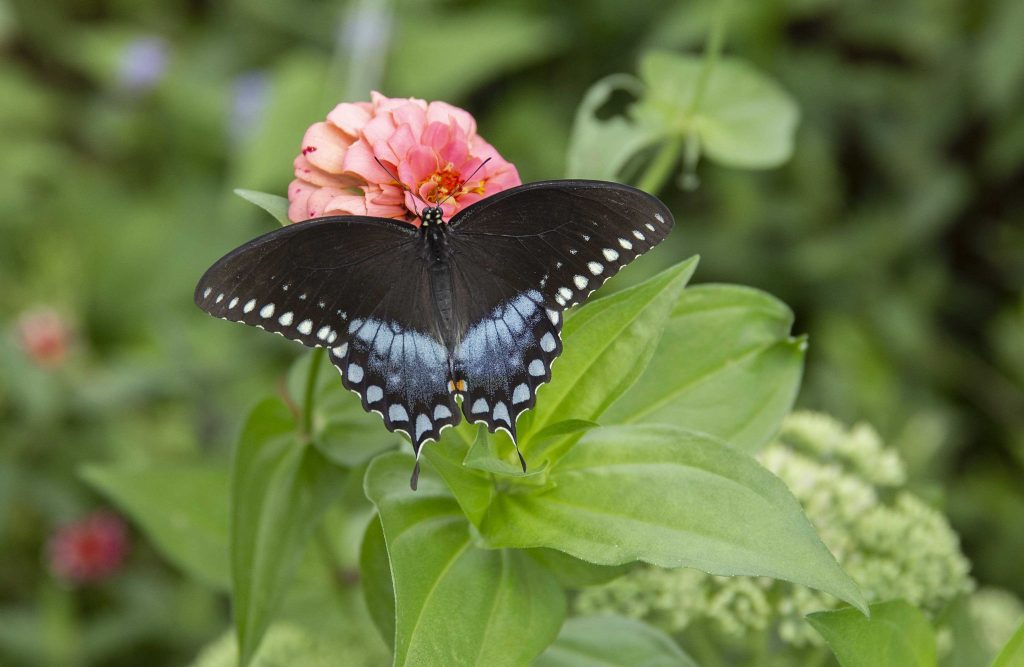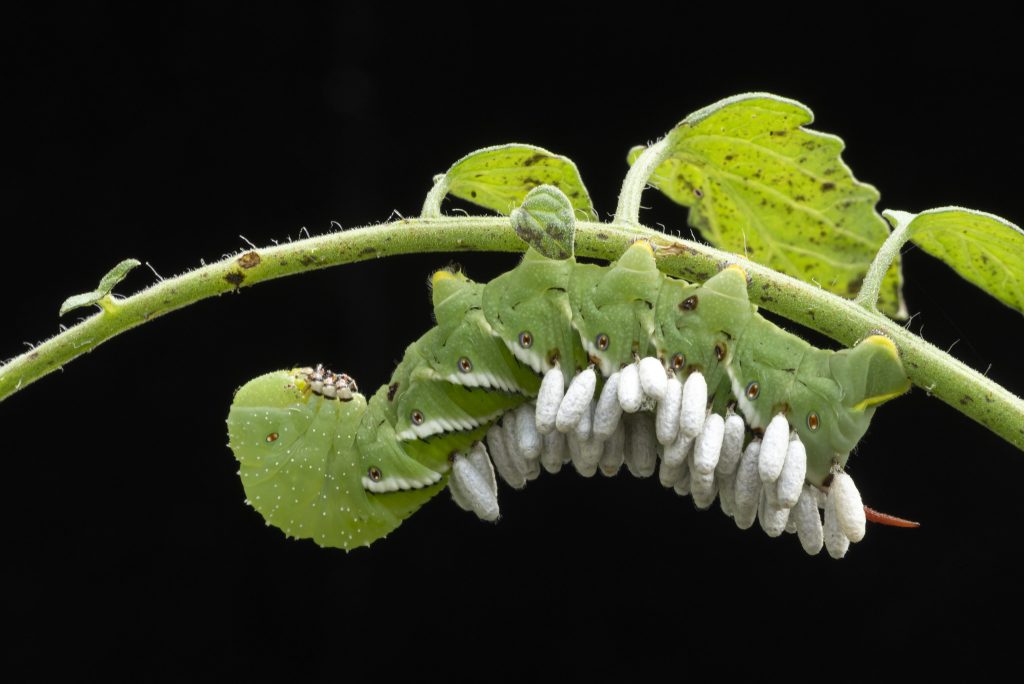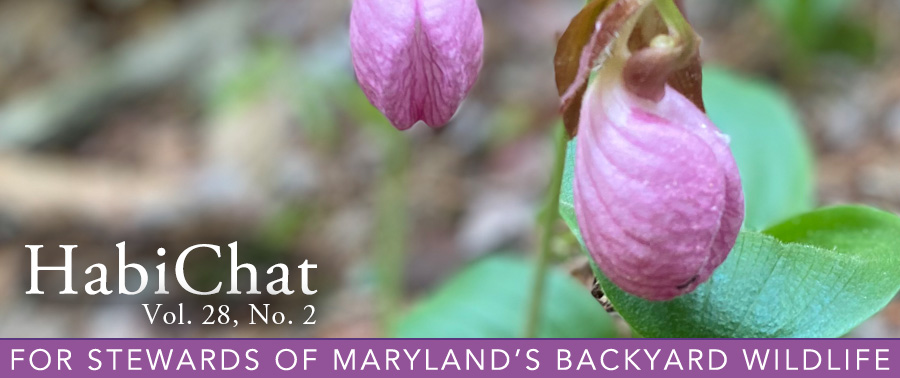By Paula Becker

Black swallowtail, photo by Jennifer Fry, submitted to Maryland DNR Photo Contest.
It’s high summer. The morning sun rises with the songbird chorus. Dew glistens on last night’s webs draped on opening blooms. Vegetables swell and ripen. And insects flit about, flying in your mouth when you ride your bike, buzzing in your ears, and chowing down on your expensive landscaping plants. What’s a gardener to do about all these pests?
Let’s back up. Is an insect really a pest? Does it have to be dealt with? Are you the one who has to do the dealing? Let’s investigate these questions, and save ourselves some time and money while also protecting our natural communities. Integrated Pest Management (IPM) is the art and science of using many strategies, including natural controls, to balance our needs with the natural world. Here are some concepts to keep in mind.
The vast majority of insects are either beneficial to humans or neutral; they don’t cause any lasting problems. Of the 1.5 million known species of insects found worldwide, 95 percent are considered “the good guys.” In some studies, “the bad guys” are only 1-3 percent. This includes insects that may carry disease, sting or bite, or damage infrastructure or crops. These harmful insects can often be controlled using a variety of targeted techniques that avoid killing our beneficial bugs or having a negative effect on the natural community as a whole. For instance, leaf-cutter bees cut almost perfect circles in leaves as they gather materials to create their nests. They don’t harm the redbud or rose or hosta, and they are vital for pollinating flowers we love and foods that we enjoy, like blueberries, onions, and sunflowers. These plants and bees are part of a healthy functioning system that supports both the plant and the pollinator. Imperfections are a beautiful part of the life cycle.

Tobacco hornworm with parasitic wasps, photo by Wayne Wolfersberger
Let’s reset our expectations. Are those eastern tent caterpillars really harming that cherry tree? Will the tree suffer because hungry, hungry caterpillars eat all the leaves? Or does it merely look less than social media-ready for a few weeks? Maybe knowing that spring caterpillars are an essential food source for migrating and breeding songbirds can ease the sense of impending doom, and remind us that evolution has brought these species together. Sometimes, pests are bird food. And the tree will recover just fine. Other natural predators include frogs and toads, predatory insects like dragonflies and wasps, fish, and bats. Total eradication is unrealistic and can cause an imbalance. Getting pest numbers to a comfortable level is easier and more sustainable. If you include supportive habitat in your yard, you can reduce the pest problem. Check out the Wild Acres pages for tips on being a good natural neighbor.
OK, so what about actual pests who do real harm? Here are some strategies to reduce the impacts without all the collateral damage:
Alter the Attraction: Harmful insects enter our yards because we have something they want: habitat. Food, water, or shelter may bring them to the yard, so maybe change the allure. If you have a water feature, add a small solar fountain or recirculator to prevent stagnating water where mosquitoes like to breed. Dump any standing water in pots. Or, you can use a strategy embraced by our friends at “Homegrown National Park” and create a mosquito bucket trap. In a 5-gallon bucket, place 3-4 handfuls of straw or grass clippings. Add water to the halfway mark. Allow the mixture to ferment for a few days then add a Mosquito Dunk or other brand containing Bacillus thuringensis (BT), which kills mosquito larvae. Place chicken wire over the bucket to allow the adult mosquitoes in but keep out other critters. Place the bucket where mosquitoes congregate in your yard. Check it every 2 weeks and clean it out when necessary. Most dunks are good for 30 days.
Phone a friend: In general, planting native flowers as companions around vegetable crops increases pollination of the vegetables by supporting additional needs of pollinating insects. For example, wild bergamot is a terrific addition to your food landscape. But many types of flowers also actively repel harmful insects. Marigolds (not native to Maryland but also not invasive) are a brilliant orange, workhorse bedding plant that will deter insects with piercing mouthparts (like white flies and thrips) and save your tomatoes if you plant them together. Research also shows that marigolds protect tomatoes from harmful root-knot nematodes in the soil. Radishes are not only a delicious peppery complement to your salad but they also hold off cucumber beetles and cabbage maggots. Tuck them in with carrots, peas, cucumbers, and tomatoes; but keep them away from broccoli. Common herbs, like chamomile, rosemary, thyme, and parsley, not only repel some members of the Gardener’s Least Wanted List – like potato bugs, aphids, armyworms, cutworms, and mosquitoes – but also attract beneficial pollinators and other predatory insects that feed on garden pests. Beneficial wasps (yes, wasps) will take out those tomato hornworms, cabbage loopers, and sawflies. And they’re not interested in stinging you if you respect their personal space. An added benefit of parsley is that it is a host plant for the black swallowtail butterfly! Plant some to feed the caterpillars and have enough for a batch of tabbouleh. Most plants that have strong aromas, like geraniums, lavender, marigolds, basil and other herbs, have evolved these scents as a defense against hungry insects. As long as the plants are not invasive (watch out for some of those nonnative mints), you can use their repellant skills to your advantage and add some of them to your salad!
Don’t mind me, I’ll just pick! Sometimes, the pest pressure is low enough that you can simply pick them off by hand. Japanese beetles on roses are easily flicked into a bucket of soapy water. Aphids are stripped from a soft plant stem with thumb and forefinger with alacrity. Try it – it’s very therapeutic. You don’t have to get them all to keep the system in balance.
Sometimes, an insect infestation is just too overwhelming to get with hand-picking or waiting for the natural predators to step up. Targeted use of an insecticide can be a last resort. There is no universal pesticide, but there are many home remedies, like a soapy dish detergent spray, that work well without impacting the plants, soil, or beneficial insects. This type of spot cleaning works well for soft-bodies insects like aphids, thrips, and whiteflies. It just requires some personal attention and a little quality time in the garden. (And FYI – sometimes a strong hose spray is sufficient. Just watch the tender plants.)
An effective but simple recipe for a soap spray is 2 teaspoons of dish soap to 1 pint of water. This will create a 2% solution, which is sufficient to kill an aphid but not burn the plant. The solution must touch the insect, so you can’t pre-spray before you see the offending arthropod. And you will need to reapply after a week, or sooner if it rains. Applications should also only occur at temperatures below 90 degrees and when the humidity is not high. Know your plants; a stressed plant will not respond well to additional pressures and some are more sensitive to the solution. Cherries, hawthorns, and plums can be “burned” by the soap. Commercially available soap-based insecticides are also available; the same precautions apply. Be wary of any recipe that includes vinegar. Although it can be helpful in the short term, kitchen vinegar is a 5% acid solution and will burn plants and can impact soil health. Herbicidal vinegar used in weed sprays is a 10-20% solution and can harm important soil microbes.
In recent decades, we have become more savvy about the use of synthetic chemical pesticides in our landscaping. We have learned about the unintended consequences of using the wrong chemical in the wrong way. If you choose to go the route of commercial pesticides, make sure you know, understand, and follow all the safety precautions, both for the human applying the chemical and for the surrounding environment, including water and soil resources. Use just what is needed, no more, no less.
So let’s get out there and be an active, thoughtful supporter of our gardens! Just don’t try to kiss a wasp on the lips.
More resources:
Maryland Department of Agriculture – Tips on Pesticide Alternatives
University of Maryland Extension – June Gardening Tips
The Bug Guy’s Advice

Visit Us Online!

Black swallowtail, photo by Jennifer Fry, submitted to Maryland DNR Photo Contest.
It’s high summer. The morning sun rises with the songbird chorus. Dew glistens on last night’s webs draped on opening blooms. Vegetables swell and ripen. And insects flit about, flying in your mouth when you ride your bike, buzzing in your ears, and chowing down on your expensive landscaping plants. What’s a gardener to do about all these pests?
Let’s back up. Is an insect really a pest? Does it have to be dealt with? Are you the one who has to do the dealing? Let’s investigate these questions, and save ourselves some time and money while also protecting our natural communities. Integrated Pest Management (IPM) is the art and science of using many strategies, including natural controls, to balance our needs with the natural world. Here are some concepts to keep in mind.
The vast majority of insects are either beneficial to humans or neutral; they don’t cause any lasting problems. Of the 1.5 million known species of insects found worldwide, 95 percent are considered “the good guys.” In some studies, “the bad guys” are only 1-3 percent. This includes insects that may carry disease, sting or bite, or damage infrastructure or crops. These harmful insects can often be controlled using a variety of targeted techniques that avoid killing our beneficial bugs or having a negative effect on the natural community as a whole. For instance, leaf-cutter bees cut almost perfect circles in leaves as they gather materials to create their nests. They don’t harm the redbud or rose or hosta, and they are vital for pollinating flowers we love and foods that we enjoy, like blueberries, onions, and sunflowers. These plants and bees are part of a healthy functioning system that supports both the plant and the pollinator. Imperfections are a beautiful part of the life cycle.

Tobacco hornworm with parasitic wasps, photo by Wayne Wolfersberger
Let’s reset our expectations. Are those eastern tent caterpillars really harming that cherry tree? Will the tree suffer because hungry, hungry caterpillars eat all the leaves? Or does it merely look less than social media-ready for a few weeks? Maybe knowing that spring caterpillars are an essential food source for migrating and breeding songbirds can ease the sense of impending doom, and remind us that evolution has brought these species together. Sometimes, pests are bird food. And the tree will recover just fine. Other natural predators include frogs and toads, predatory insects like dragonflies and wasps, fish, and bats. Total eradication is unrealistic and can cause an imbalance. Getting pest numbers to a comfortable level is easier and more sustainable. If you include supportive habitat in your yard, you can reduce the pest problem. Check out the Wild Acres pages for tips on being a good natural neighbor.
OK, so what about actual pests who do real harm? Here are some strategies to reduce the impacts without all the collateral damage:
Alter the Attraction: Harmful insects enter our yards because we have something they want: habitat. Food, water, or shelter may bring them to the yard, so maybe change the allure. If you have a water feature, add a small solar fountain or recirculator to prevent stagnating water where mosquitoes like to breed. Dump any standing water in pots. Or, you can use a strategy embraced by our friends at “Homegrown National Park” and create a mosquito bucket trap. In a 5-gallon bucket, place 3-4 handfuls of straw or grass clippings. Add water to the halfway mark. Allow the mixture to ferment for a few days then add a Mosquito Dunk or other brand containing Bacillus thuringensis (BT), which kills mosquito larvae. Place chicken wire over the bucket to allow the adult mosquitoes in but keep out other critters. Place the bucket where mosquitoes congregate in your yard. Check it every 2 weeks and clean it out when necessary. Most dunks are good for 30 days.
Phone a friend: In general, planting native flowers as companions around vegetable crops increases pollination of the vegetables by supporting additional needs of pollinating insects. For example, wild bergamot is a terrific addition to your food landscape. But many types of flowers also actively repel harmful insects. Marigolds (not native to Maryland but also not invasive) are a brilliant orange, workhorse bedding plant that will deter insects with piercing mouthparts (like white flies and thrips) and save your tomatoes if you plant them together. Research also shows that marigolds protect tomatoes from harmful root-knot nematodes in the soil. Radishes are not only a delicious peppery complement to your salad but they also hold off cucumber beetles and cabbage maggots. Tuck them in with carrots, peas, cucumbers, and tomatoes; but keep them away from broccoli. Common herbs, like chamomile, rosemary, thyme, and parsley, not only repel some members of the Gardener’s Least Wanted List – like potato bugs, aphids, armyworms, cutworms, and mosquitoes – but also attract beneficial pollinators and other predatory insects that feed on garden pests. Beneficial wasps (yes, wasps) will take out those tomato hornworms, cabbage loopers, and sawflies. And they’re not interested in stinging you if you respect their personal space. An added benefit of parsley is that it is a host plant for the black swallowtail butterfly! Plant some to feed the caterpillars and have enough for a batch of tabbouleh. Most plants that have strong aromas, like geraniums, lavender, marigolds, basil and other herbs, have evolved these scents as a defense against hungry insects. As long as the plants are not invasive (watch out for some of those nonnative mints), you can use their repellant skills to your advantage and add some of them to your salad!
Don’t mind me, I’ll just pick! Sometimes, the pest pressure is low enough that you can simply pick them off by hand. Japanese beetles on roses are easily flicked into a bucket of soapy water. Aphids are stripped from a soft plant stem with thumb and forefinger with alacrity. Try it – it’s very therapeutic. You don’t have to get them all to keep the system in balance.
Sometimes, an insect infestation is just too overwhelming to get with hand-picking or waiting for the natural predators to step up. Targeted use of an insecticide can be a last resort. There is no universal pesticide, but there are many home remedies, like a soapy dish detergent spray, that work well without impacting the plants, soil, or beneficial insects. This type of spot cleaning works well for soft-bodies insects like aphids, thrips, and whiteflies. It just requires some personal attention and a little quality time in the garden. (And FYI – sometimes a strong hose spray is sufficient. Just watch the tender plants.)
An effective but simple recipe for a soap spray is 2 teaspoons of dish soap to 1 pint of water. This will create a 2% solution, which is sufficient to kill an aphid but not burn the plant. The solution must touch the insect, so you can’t pre-spray before you see the offending arthropod. And you will need to reapply after a week, or sooner if it rains. Applications should also only occur at temperatures below 90 degrees and when the humidity is not high. Know your plants; a stressed plant will not respond well to additional pressures and some are more sensitive to the solution. Cherries, hawthorns, and plums can be “burned” by the soap. Commercially available soap-based insecticides are also available; the same precautions apply. Be wary of any recipe that includes vinegar. Although it can be helpful in the short term, kitchen vinegar is a 5% acid solution and will burn plants and can impact soil health. Herbicidal vinegar used in weed sprays is a 10-20% solution and can harm important soil microbes.
In recent decades, we have become more savvy about the use of synthetic chemical pesticides in our landscaping. We have learned about the unintended consequences of using the wrong chemical in the wrong way. If you choose to go the route of commercial pesticides, make sure you know, understand, and follow all the safety precautions, both for the human applying the chemical and for the surrounding environment, including water and soil resources. Use just what is needed, no more, no less.
So let’s get out there and be an active, thoughtful supporter of our gardens! Just don’t try to kiss a wasp on the lips.
More resources:
Maryland Department of Agriculture – Tips on Pesticide Alternatives
University of Maryland Extension – June Gardening Tips
The Bug Guy’s Advice

Visit Us Online!
